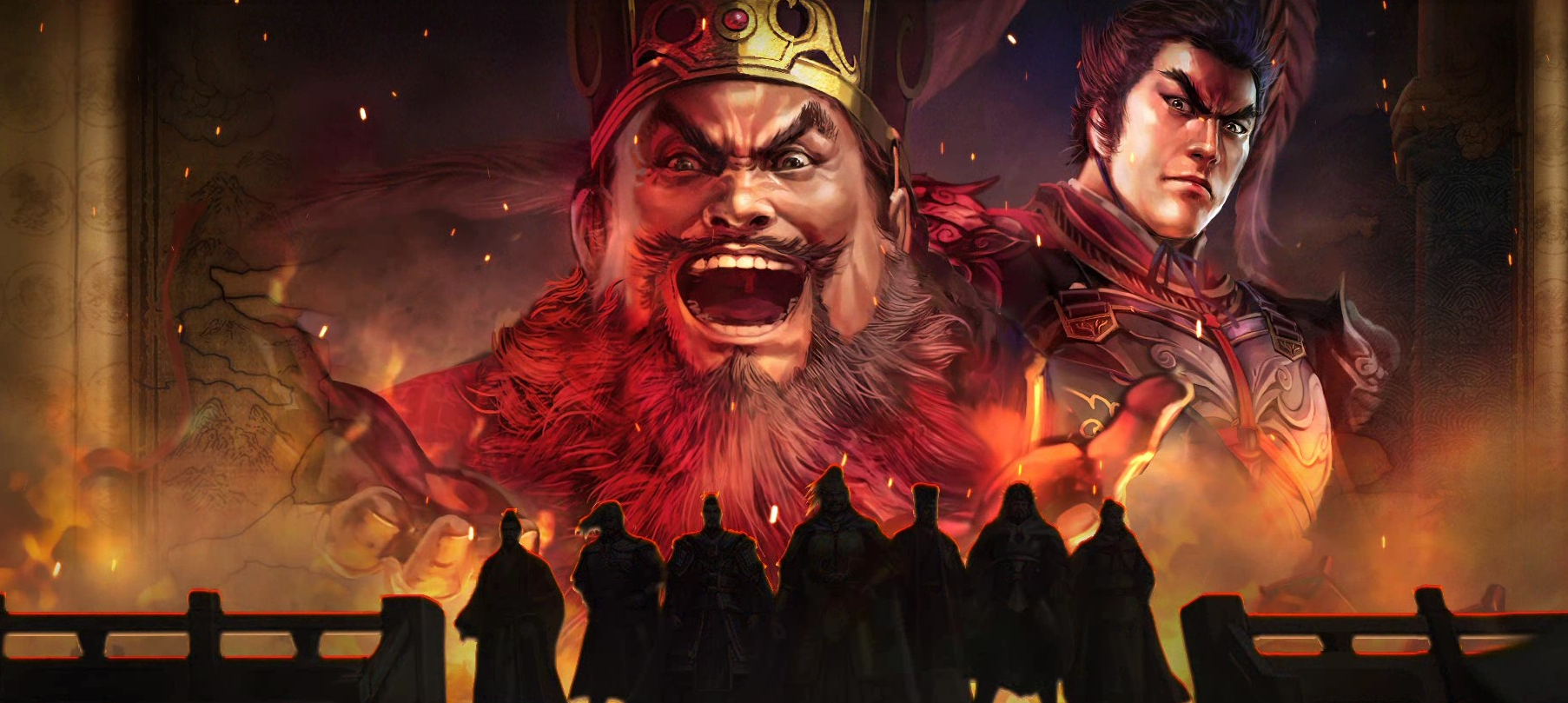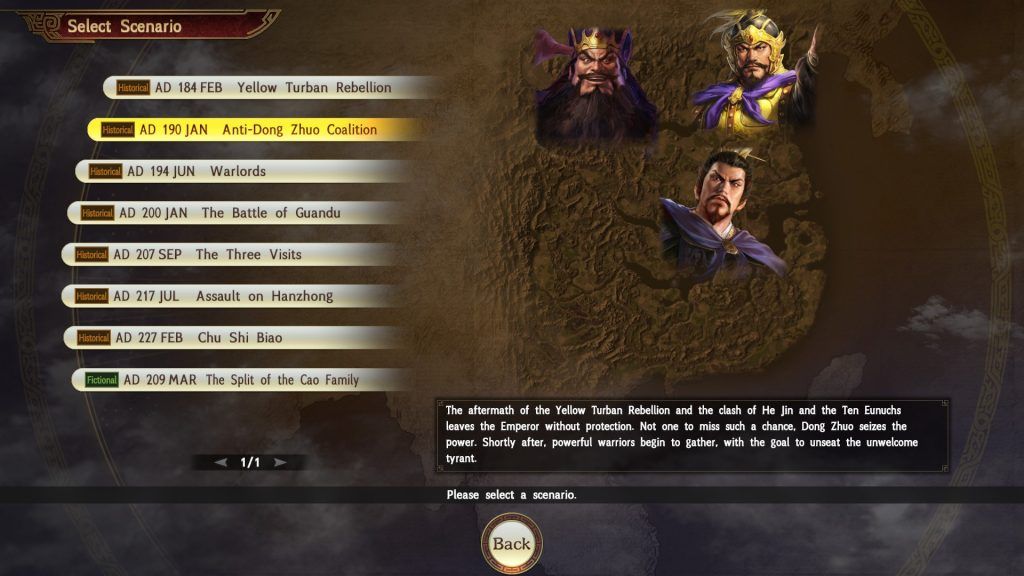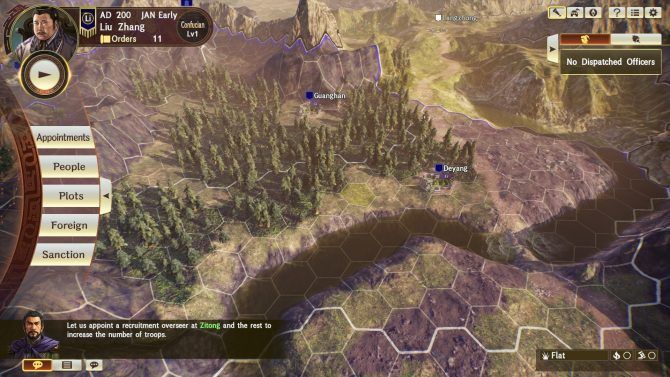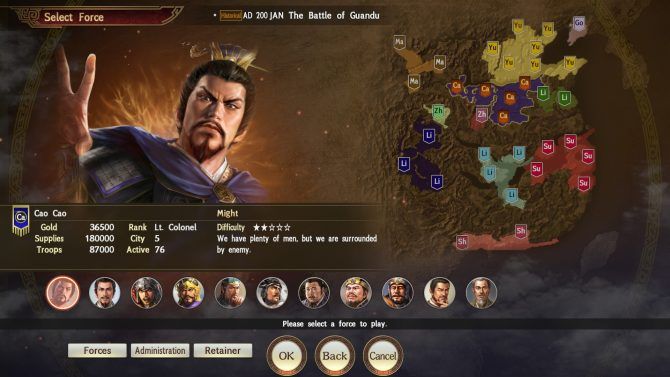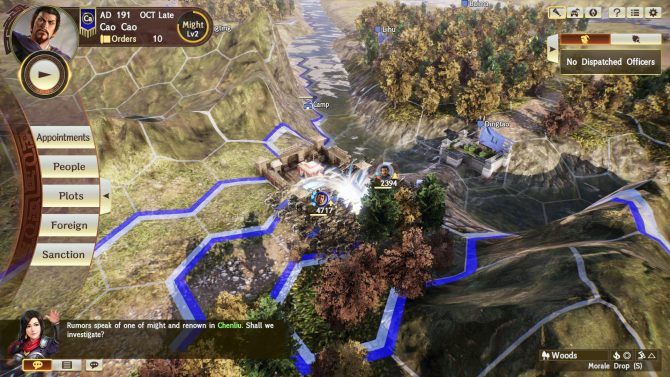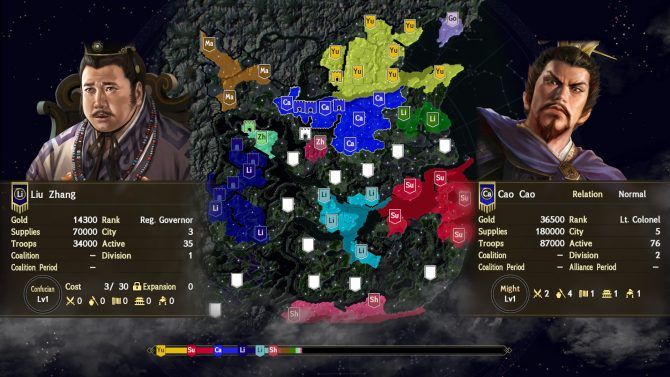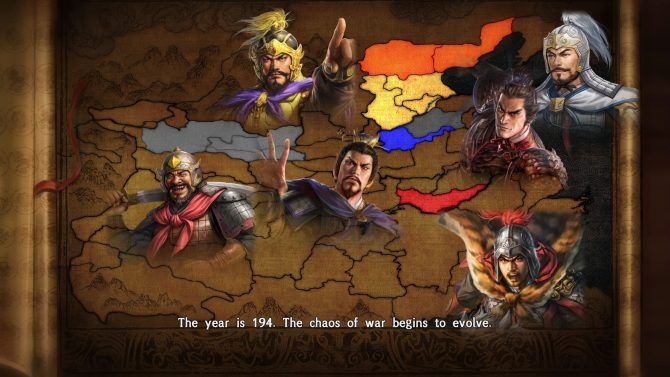I went into this game with no experience of the Romance of the Three Kingdoms series of strategy games. The closest I could offer is having an avid player of all sorts of strategy games, both real-time and turn-based. I also know the source material pretty well, both through the original Romance of the Three Kingdoms book and a smattering of Dynasty Warriors games (also by Koei Tecmo) over the years. Having now played this latest entry, I am more curious about the previous titles… but I have no desire to continue playing XIV.
[pullquote]"Having now played this latest entry, I am more curious about the previous titles… but I have no desire to continue playing XIV."[/pullquote]
For those not familiar, Romance of the Three Kingdoms dramatises a real period in ancient Chinese history. As the name suggests, it involves the various wars and political machinations of three kingdoms, all of which sought to unify China under their banner. With multiple factions and a huge selection of characters -- real or otherwise -- to draw from, it’s an excellent stage to host a strategy game in. Or, y’know, massively over the top action games with huge rosters… but that’s for a different review.
At its core, Romance of the Three Kingdoms XIV is a wargame with a smattering of empire management aspects. Though there are aspects of diplomacy and means of advancing without direct combat, it’s impossible to avoid in the long run. This title doesn’t offer the flexibility that something like Civilization can provide, let alone a Paradox grand strategy game. Sooner or later, you’re going to be throwing armies at people. So let’s talk about the systems surrounding it before we dive in to the wars.
Starting a new game will see you pick a scenario from about a dozen, each set in a different part of the timeline. You’ll pick a faction leader to play as, assuming control of whatever holdings and retainers they have at that point. From there, your objective is simple: beat everyone else and unify China. Some starting situations make this more challenging than others, but that’s always your end goal.
Managing your burgeoning empire is fairly straightforward. The map is split up into many provinces, with large cities dotting the landscape. Cities are the heart of your territory, and claiming the provinces around them feeds their resource production into the nearest city. Acquiring new provinces is as simple as marching an army in to claim their “core,” or else deploying a diplomat to woo them with gold instead. Provinces are further split up into many smaller tiles. The more of them you “paint” your army’s colour through troop movements, the more possession and therefore resources the province has.
There are only three major resources in the game: gold, supplies, and troops. Once a province is yours, you can assign a governor from among your officers to run it. They will then improve the building type according to the resource that you select (Commercial, Agricultural, or Barracks) and will gradually improve it as turns go by. This is the beating heart of your conquest of China; it’s one big land grab to take and hold as much territory as possible.
So, let’s talk about those officers. Each ruler you can select will start with their retinue of officers. More can be acquired either by sending your existing officers out to find talent or else try and sway the loyalty of other faction’s leaders to your service. You can also make your own officers, either to serve as a faction leader or just to populate the world... which also means you can make some pretty powerful characters right out of the gate. Officers have a selection of stats and traits to determine what they’re best at; you don’t want your genius accountants leading an army, for example. Ultimately, it becomes a juggling act of putting the right governors in the right place to develop your provinces accordingly.
[pullquote]"It’s one big land grab to take and hold as much territory as possible."[/pullquote]
Beyond this placement of governors, though, there’s very little active management for the player to do. Provinces will build up over time with little oversight, and there’s very little infrastructure management -- no building wonders or anything like that. You’re given a limited number of Orders per turn, which are taken up by assigning officers to a post or a task (recruiting, diplomacy, espionage etc.). Once you're out of Orders, you can tweak existing ones or move already deployed troops, or else end your turn.
What I found was that after the early setup of my empire, I was mostly just deploying the officers to search my cities for loose change or wandering recruits. There’s a number of Titles you can assign to your retinue, but this mostly amounts to giving them a few stat boosts. Likewise, you can appoint them to your Administration, wherein each officer has a passive ability they grant to strengthen your overall kingdom. Again, though, this is something you’ll not be doing too much after your early days of setup until you hit new milestones.
Other options for your officers include undertaking Sanctions or Plots wherein your officers will make suggestions at the expense of an Order. This ultimately amounted to “throw gold to speed up the development of a region,” boost morale, or else hit an invader with a debuff. Plots are ostensibly more interesting; you have options to poison leaders, shake up loyalty, incite rebellion, and things like that. Sadly though, these also amount to paying gold and rolling the dice to see if you can destabilize an enemy indirectly.
The management side of things doesn’t really expand once you get some cities under your belt, either. You can go through all your busywork manually, but it’s entirely feasible to assign these cities to a new division under AI leadership. You set them with a task and a target -- build up resources, reinforce a different city, attack a specific base -- and they’ll happily set about doing that quite competently. After some time trying to handle things directly, I just let them handle it for me and requisitioned most of their troops for my own forces when the wargame kicked in. The difference in result was fairly minor... and in some cases, I swear my AI officers were producing far more than I feasibly could've.
So, everything in Romance of the Three Kingdoms XIV is building up towards this wargame. I was hoping this would turn out to be more interesting than the empire management, but alas, it really wasn’t.
Officers are once again the core of the military gameplay. When choosing to march out an army, you’ll select an officer to lead that force. You’ll pick the formation of the army, which determines their stats and effectiveness (or whether or not they’re using a siege weapon) and is probably the most important choice available. You then assign however many troops the officer is leading -- each individual has a cap -- and then send them off into the field. You can adjust their orders every turn even if they’re out in the field, so no worries about committing to a suicide mission by mistake.
And that’s basically all there is to it. Once your armies are on the move, you can point them at a destination or a target and they’ll move there to the best of their ability. You can also assign them to build various structures on the map, such as arrow towers or blockades. If they come in contact with enemies, they’ll attack. Generally, a higher stat officer with a bigger host in a suitable formation will win.
Of course, that’s not always the case. Sending multiple forces at once to catch enemies in pincer moves or rear assaults is always effective. The previously mentioned Sanctions can inflict pretty devastating ailments on your foes to buy you a significant advantage. Troop counts may serve as an unofficial health bar, but there’s also the army’s Morale to consider. If that bar empties, the entire group will just ditch the fight and run away, instantly granting you the day.
[pullquote]"Everything in Romance of the Three Kingdoms XIV is building up towards this wargame. I was hoping this would turn out to be more interesting than the empire management, but alas, it really wasn’t."[/pullquote]
Crucially though, your officers come equipped with various traits and Tactics that can influence things. If all the prior conditions are met (formations, positions etc.) and then you happen to have fitting RNG, the camera will focus on your officer as they unleash their named Tactic and inflict a large hit.
It really is random on whether or not these abilities fire, however. You might think giving a rousing speech that inspires your troops is best used when you have your full army of 6000 marching into battle… only for the speech to happen when there are 10 guys left. Alas, that seemed to be the case for me more often than not. You’ll still want to factor them in when deploying your troops -- some officers have joint attacks or tactics if moving forces alongside each other -- but it’s risky to rely purely on them. Sound tactics and deployments will win you the day more frequently.
One of the major additions and systems in Rot3K XIV is the notion of supply lines. As armies move across provinces, they’ll paint the tiles with their faction’s colour. If there’s a clear line between their nearby provinces and their current position, they’ll gain increased stats and power. On the other hand, a deep strike into enemy territory can see an enemy force just retake the supply lines behind you, tanking your morale and forcing desertions in no time once you run out of food. You’ll want to advance and conquer methodically and protect your supply lines, as a result.
From my experience with the game though, the AI didn’t seem to take this to heart very much. I’d get large hosts charging straight for my cities quite often. All it took was a small force maneuvering behind to cut their supply lines, and boom. They’re doomed to a war of attrition against my walls that they inevitably lose. I’ve seen complaints that the game is too easy even on Hard difficulty, and given that the only major change I observed between difficulties seemed to be RNG success rates, I’d believe that to be the case.
So, even if you choose not to exploit this mechanic, the wargame aspect is still fairly straightforward. I’m not employing major strategies, customizing my army layout, or assembling different units. It’s just letting my empire build up until I have enough troops to do something with, then sending them on their merry way. Yes, I’ll still need to maneuver them around based on changes in the situation, but so much of the thought process behind it seemed very basic.
This is, unfortunately, the takeaway I got from playing Romance of the Three Kingdoms XIV. As I got used to the process of managing and automating the fairly simple kingdom processes, I couldn’t help but feel like I was playing an ascended mobile game. It didn’t help that the overall presentation and polish of the game felt somewhat cheap and disposable. The art is quite nice, but officer portraits are given very simplistic animations and the 3D models are very basic when used. The music is fairly repetitive, with very few different tracks that I heard. Playing the PC version, the startup menus and settings felt very cheap, and signs of a less than thorough localization are present. That extended further to general poor performance and sluggishness; despite the low graphical intensity, the game feels really poorly optimized. Even the presentation on the website seemed to have more polish.
While I didn’t experience any major bugs or crashes, there was one glaring issue: the calculations regarding supplies. As one of your major resources, you kind of want to keep a surplus of this, and so I did… according to all the in-game numbers and readouts. Nonetheless, I would frequently find that I was getting a lot fewer supplies than I was supposed to, occasionally leading to cities getting shortages. Even factoring in that the expense triggers three times per month but the income only once, I was still coming up short. Checking discussions on Steam showed that I wasn’t alone in this.
[pullquote]"I couldn’t help but feel like I was playing an ascended mobile game."[/pullquote]
I had to ballpark how much I really needed, trying to guarantee I never came close to anything resembling a shortage risk. Even so, I'd still get warnings, and once had a huge army quit the field instantly because I couldn't keep them supplied despite my best efforts. That made the empire management even more annoying, but since my automated governors could apparently handle it, I just went hands-off after a while. It's hardly an encouraging thing to have happen, though.
Overall, it just has the feel of a game developed on a budget. This wouldn’t be a bad thing, but the game’s price ends up making that feel very conflicting, especially since there’s a Season Pass available. The previous Romance of the Three Kingdoms got an expansion pack in addition to various cosmetic or scenario DLCs, which I fully expect to see happen here. This is a kind of standard for Koei Tecmo’s games at this point; you need only look to the number of releases and DLC packs each Dynasty Warriors game receives in a lifetime to affirm it.
With all of this in mind, I ended up walking away with extremely mediocre feelings about the game. Romance of the Three Kingdoms XIV plays decently enough, but it felt so basic and barebones that I had exhausted what there was to see mechanically before I hit double-digit hours of playtime. The extra scenarios and various historical events didn’t really go far enough in glossing over how simplistic the whole game felt.
Fans of the series and setting will probably find validation and likable aspects here, but I wouldn’t suggest jumping in here if you’re unfamiliar. There are better strategy games out there for cheaper with more depth, options, and personality than this one. By the end, I preferred the idea of just playing Civilization VI as China -- that’d probably be a more fun evening of strategy for me.
Romance of the Three Kingdoms XIV
- Platform
- PS4, PC
- Developer
- Koei Tecmo
- Publisher
- Koei Tecmo
- Genre
- Simulation, Turn-Based Strategy

